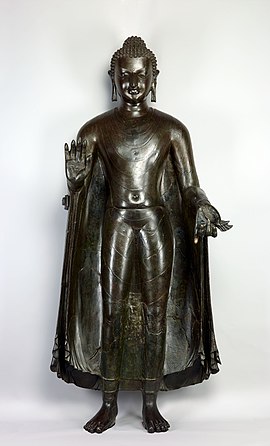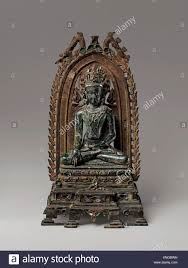Pala dynasty ruled over Bihar and Bengal area from 8th to 12 century. Apart from being astute diplomats and military conquerors Pala rulers were also great patron of Art and architecture. The new style of Arts developed under their patronage are called Pala arts.
The Pala arts can be discussed under following heads:
- Sculpture
- Terracotta figurines
- Paintings
- Architecture
Sculpture:
- The Pala school of sculptural art is recognised as a distinct phase of the Indian art, and is noted for the artistic genius of the Bengal sculptors.
- A new style of stone and bronze sculpture emerged during Pala period.
- Main propounder of this school of art were Dhiman and Vithpal, who were contemporary of Dharmpal and Devpal respectively.
- Bronze sculpture:
- Bronze was casted by ‘Cire perdue’ method.
- The scuptures are generally Ornamented.
- The Buddist centre of Kukrihar and Nalanda are the main centers. In Nalanda, it appears to have formed the part of the Curriculum. ©crackingcivilservices.com
- The themes of the bronze sculpture:
- are largely Buddhist,
- few of the Brahmanical images of Tantrik influence like that of Ganga, Balarama (also from Kukrihar) Vishnu and Surya have also been recovered from Nalanda.
- The bronze image at Nalanda and Kukrihar mostly portray the Buddha and Bodhisattvas including Avalokitesvara, Manjushree, Maitreya and Vajrapani and other Buddhist gods and goddesses such as Jambhala, Haygriva, Tara, Prajnaparamita, Vasudhara, Hariti and Parnasavari.
- Buddha is represented:
- standing with the right hand held in the Varda (blessing) and ‘Abhaya’ mudra (poise)
- as seated in the ‘dhumisparsa‘ (enlightment) and dharamchakra mudra (first sermon).
- Examples:
- Largest bronze image has been recovered from Sultanganj, which presently is at Birmingham Museum, UK.

-
- From Kukrihar, crowned images of Buddha have been found.

- Standing Buddha from Nalanda with the right hand in abhaymudra, is one of the finest piece of bronze sculpture in the Eastern School because of its dignity, convincing modelling and inner poise.

- Standing Tara from Nalanda

- Balarama, bronze sculpture from Kurkihar

- Stone Sculpture:
- Stone sculptures were also elegant in style, precise technically and harsh outline akin to metal work.
- Main characteristic of these sculptures are as follow:
- Mostly made of black basalt stone. These were readily available in the hills of Santhal Paragna region and Munger district.
- Generally the front part of the body has been tried to be shown. Rear part of the Images has hardly been artistically built.
- Most of the images are of gods and goddesses especially of Bodhisattvas. Important life events of Lord Buddha have been especially depicted.
- Brahamanical gods like Vishnu, Shiva or Jain sculptures are also found but they are comparatively less in numbers.
- All the images are excellent and exhibit the maturity of the artist especially regarding their craftsmanship. Ornamental decoration pf these images has made them more attractive.
- Limitations:
- Pala sculpture is criticized for lacking originality.
- They lack simple aesthetic sense which are easily found in Gupta sculpture.
- Images have been heavily ordained with ornaments, which confers them look like an artificial ones.
- Even in the images of gods and goddesses, human beauty has been attempted to be interposed.
- Even Tantric influences are also manifested on account of which female body has been intertwined, exhibiting apparent sensuousness. ©crackingcivilservices.com
Terracotta figurines:
- Terracotta images of this period are artistic and charming.
- Some noticeable images have been recovered from the remains of Vikramshila Maha Vihar.
- Such terracotta figurines were made to adore the walls.
- These depict the scenes from religion as well as from day-to-day life.
- So, on the basis of these images, history of living standards, dresses, activities etc. of ordinary people of this period can be re-constructed.
- Along with Buddha and Bodhisattavas, images of Vishnu, Varah, Sun, Hanuman and Ardhnarishwar show the influence of Hindu religion.
- Artistic beauty has been shown on the terracotta figure of a sitting lady, who holding a mirror in one hand appreciating her own beauty and with fingers of another hand she is putting up vermillion on her head. Her body has been beautified successfully by not only ornamentation but also by innocence of face, slender waist and prominent breast.
Paintings:
- Paintings of Pala period are availabe in two forms:
- Manuscript Painting
- Mural Painting
- Manuscript Painting:
- Painted manuscipt was generally written on Palm leaves.
- Examples: (These are presently preserved in Cambridge University.)
- Ashtasahasrika,
- Pragya-parmita and
- Panchraksh.
- Around one hundred miniature picture are made upon them.
- These not only depict the various scenes of Buddha but also contain the gods and goddesses of Mahayana sect in various pose.
- Colors used:
- primary colours like red, white, blue, black.
- secondary colours like green, violet, light pink and Grey.
- Painting of Pala period perpetuates the tradition of Ajanta painting with sensuous bias of Eastern India.
- The Pala School of painting is characterized by delicate and nervous lines, sensuous elegance, linear and decorative accent.
- The impact of Tantric art on these paintings are easily visible.
- Sometimes, it also resembles some of the qualities of Nepalese and Burmese Art.
- Mural or Wall Painting:
- Mural Painting has been found at Sarai Sthal at Nalanda.
- Here, at the bottom of a platform, made of grantie stone, flowers of geometrical shapes, images of animals and humans are noticeable even after fading.
- Certain images of elephants, horses,dancers, Bodhisattavas etc, can be noticed.
- Impact of Ajanta and Bagha Cave Painting is easily noticeable because the way of making images and manner of paintings are almost the same. ©crackingcivilservices.com
- Mural Painting has been found at Sarai Sthal at Nalanda.
Architecture:
- Pala Kings also contributed significantly in the field of architecture.
- Mostly bricks are made, some also use stones.
- Also influenced by religion, especially Buddhism [Pal dynasty ruler and Buddhist followers] and Hindu temples.
- Monastery (Viharas): They got built Buddha vihar and temple at Nalanda, Vikramshila, Odantpuri, Sompuri etc.
- Different styles was adopted for making Vihara:

- The most important examples of Buddhist architecture in the Pala period appear in the context of “Monastery”. These Viharas {Monasterys} were originally built from the residence of monks and from the academic point of view.
- Odantpuri Monastery by Devapala.
- this mahabihara was so significant that it served as a model for the 1st monastery built in Tibet.
- Vikramashila Monastery(Most Important) by Dharmapala.
- Vikramashila Monastery is the most Discussed and Excellent among Pal Monastery.
- At Vikramshila, ruins of a temple and a stupa have been found. ©crackingcivilservices.com
- Sompura Monastery(present-day Bangladesh) by Dharmapala (by not clear).
- Odantpuri Monastery by Devapala.
- Temples:
- The temples are known to express the local Vanga style.
- Mahipal got built hundreds of temple and building at Kashi.
- Vishnupada temple with hemispherical mandap like umbrella at Gaya.
- Siva temple at Konch in Gaya district is architecturally important because of its pinnacle and corbelled lattice window.
- Rock-cut temple at Kahalgaon (Bhagalpur), dating from 9th century, is an interesting one as it has gabled valuted roof, which is the characteristic of South Indian Architecture.
- The 9th century Siddheshwara Mahadeva temple in Barakar in Burdwan District shows a tall curving shikhara crowned by large amalaka is an example of early Pala style.
- Many of the temples from the ninth to the twelfth century were located at Telkupi in Purulia District. They were submerged when dams were built in the region. These were amongst the important examples of architectural styles prevalent in the region which showed an awareness of all the known Nagara sub-types that were prevalent in the rest of North India.
- However, several temples still survive in Purulia District which can be dated to this period. The temples used black to grey basalt and chlorite stone pillars and arched niches.
- Many local vernacular building traditions of Bengal also inuenced the style of temples in that region. Most prominent of these was the shape of the curving or sloping side of the bamboo roof of a Bengali hut.
- Other:
- Rampal got settled a new town namely Ramavati and built there several buitdings and temples.
- Remains of Antichak and some building of Nalanda exhibited the maturity of Pala architecture.
- Besides, they also got built pond adjoined with chaitya and vihar.
Thus, Pala era through its quality sculpture, magnificent architecture and interesting painting especially manuscript one, provided continuity to the growth of art and culture in this eastern region. ©crackingcivilservices.com

